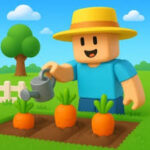Grow a Garden: A Step-by-Step Guide to Building Your Green Paradise
Growing a garden is one of the most rewarding hobbies you can adopt—whether you’re looking to beautify your space, grow your own food, or reconnect with nature. But gardening isn’t just about sticking plants in the ground and hoping they thrive. It's a mindful process that involves planning, soil knowledge, seasonal timing, pest management, and patience.
In this comprehensive guide, you’ll learn everything you need to know to grow a garden successfully—from the first shovel in the dirt to the joy of harvesting your blooms and produce. Whether you have a small balcony or a full backyard, this guide walks you through each critical phase of the gardening journey.
Understand Your Space and Environment
Before planting anything, you need to assess your available space and the environment it offers. Your garden’s size, sunlight exposure, wind patterns, and regional climate are the foundation of what will thrive—or fail.
Determine Sunlight and Soil Conditions
Most plants require at least 6 hours of direct sunlight. Observe your space throughout the day to see where the light hits and for how long. Soil testing is equally important. A simple pH kit can help you evaluate whether your soil is acidic, alkaline, or neutral.
Know Your USDA Hardiness Zone
Understanding your hardiness zone helps you choose plants suited to your region. For example, tomatoes thrive in zones 4–9, while citrus trees prefer 9–11. Planting outside your zone leads to poor growth or death over winter.
Set Clear Gardening Goals
Do you want a flower garden, a vegetable patch, or a mix of both? Setting clear goals allows you to design your space and pick appropriate plants.
Different Types of Gardens
-
Ornamental gardens focus on flowers and aesthetic design.
-
Edible gardens grow herbs, fruits, and vegetables.
-
Pollinator gardens support bees and butterflies with native plants.
Choosing a Garden Type
If you're a beginner, start small with container gardening or raised beds. This lets you control soil quality and reduces maintenance while you learn.
Plan Your Garden Layout
A well-planned layout prevents overcrowding, ensures proper spacing, and helps with maintenance and harvesting.
Use a Sketch or Digital Tool
Sketch your garden layout or use apps like Gardena or Plan-A-Garden. Include walkways, trellises, raised beds, and containers.
Companion Planting
Some plants grow better together. For example:
-
Tomatoes + Basil: Basil repels pests.
-
Carrots + Onions: Onion masks carrot scent from pests.
Proper spacing and thoughtful combinations can significantly boost yields and plant health.
Prepare the Soil
Soil is the heart of your garden. Even the best sunlight can’t save plants growing in poor-quality soil.
Soil Types and Amendments
-
Clay soil is heavy but retains nutrients well.
-
Sandy soil drains quickly but needs organic matter.
-
Loamy soil is ideal—crumbly, nutrient-rich, and well-draining.
How to Improve Soil
Add compost, peat moss, aged manure, or worm castings to enrich your soil. Test annually and amend as needed.
Choose the Right Plants
Now that your space is ready, it’s time to choose plants based on your goals, zone, and season.
Annuals vs Perennials
-
Annuals grow for one season and die (e.g., tomatoes, marigolds).
-
Perennials return year after year (e.g., lavender, asparagus).
Seasonal Planting
Spring and fall are the most active planting seasons. Be sure to check local planting calendars to align with frost dates.
Start Planting
Grow a garden planting techniques vary depending on whether you’re using seeds, seedlings, or bare-root plants.
Seed Starting Tips
-
Start indoors 6–8 weeks before the last frost for long-season crops.
-
Use seed trays and sterile potting mix under grow lights or near sunny windows.
Transplanting Tips
-
Harden off plants by gradually exposing them to outdoor conditions.
-
Water thoroughly before and after transplanting.
Direct Sowing
Easy plants like radishes, beans, or zinnias can be sown directly into the garden soil once frost risk is past.
Watering and Fertilizing Wisely
Proper watering and fertilizing are essential to plant health, especially in the first few weeks of growth.
Watering Basics
-
Water deeply but less frequently to encourage strong root systems.
-
Early morning is the best time to avoid evaporation and disease.
Fertilizer Types
-
Organic: Compost, fish emulsion, bone meal.
-
Synthetic: Fast-acting but can cause buildup or runoff.
Follow label instructions and avoid overfeeding, which can “burn” plants.
Mulching, Weeding, and Pest Management
Maintaining your garden involves fighting off weeds and pests while conserving moisture and protecting the soil.
Benefits of Mulching
-
Reduces weeds
-
Maintains soil temperature
-
Retains moisture
-
Adds nutrients as it breaks down
Use straw, shredded leaves, bark, or compost as mulch.
Pest Control Methods
-
Organic: Neem oil, insecticidal soap, diatomaceous earth.
-
Companion plants: Marigolds deter nematodes, mint repels ants.
Weeding should be done regularly, preferably after rain when the soil is soft.
Harvesting and Enjoying the Fruits of Your Labor
Harvesting is the most satisfying stage. But timing and method matter to maintain plant health and flavor.
How to Know When to Harvest
-
Tomatoes: Bright, firm, and fully colored.
-
Herbs: Harvest before flowering for best flavor.
-
Lettuce: Pick outer leaves or harvest entire heads before they bolt.
Use clean tools and avoid tearing stems to prevent damage or disease.
Preserving the Harvest
-
Drying: Herbs and chili peppers.
-
Canning: Tomatoes, beans, fruits.
-
Freezing: Berries, corn, peas.
These methods reduce waste and stretch your harvest into winter months.
Maintain and Evolve Your Garden Year-Round
Gardens are living ecosystems and evolve with each season. Don’t let your efforts fade after summer ends.
Year-Round Gardening Tips
-
Grow cool-season crops like kale, spinach, and carrots in fall.
-
Plant cover crops in winter to enrich soil.
-
Plan crop rotation to prevent nutrient depletion and disease.
Garden Journal and Reflection
Keep notes on what worked, what didn’t, and what you’d like to try next year. Photos, weather notes, and harvest records help you improve season after season.
Final Rating: 9.2/10
| Category | Score | Notes |
|---|---|---|
| Sustainability | 10/10 | Eco-friendly and low-impact |
| Reward Value | 10/10 | Tangible benefits: food, beauty, mental health |
| Time Investment | 8/10 | Requires ongoing effort |
| Cost to Start | 7.5/10 | Can be expensive initially |
| Learning Curve | 9/10 | Easy to start, endless to master |
Final Verdict: Growing a garden is a lifelong skill that pays off in food, fulfillment, and a deeper connection to the natural world. Whether you’re tending to a single tomato or managing a full backyard, gardening offers an accessible and meaningful path to wellness and sustainability.






























